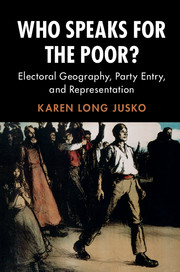Book contents
- Frontmatter
- Dedication
- Epigraph
- Contents
- List of Figures
- List of Tables
- Preface and Acknowledgments
- 1 Who Speaks for the Poor?
- 2 How Electoral Geography Matters
- 3 New Parties and the Changing Electoral Geography of Contemporary Democracies, 1880–2000
- 4 The Populists and “Third-Party Men” in America
- 5 Strategic Entry of the CCF and Social Credit in Canada
- 6 The Implications of Electoral Geography for British Labour
- 7 The Swedish Social Democratic Party, and the Long-Term Implications of Electoral Reform
- 8 “It Didn't Happen Here”: The General Implications of Electoral Geography for the Political Representation of the Poor
- References
- Index
- Miscellaneous Endmatter
5 - Strategic Entry of the CCF and Social Credit in Canada
Published online by Cambridge University Press: 05 September 2017
- Frontmatter
- Dedication
- Epigraph
- Contents
- List of Figures
- List of Tables
- Preface and Acknowledgments
- 1 Who Speaks for the Poor?
- 2 How Electoral Geography Matters
- 3 New Parties and the Changing Electoral Geography of Contemporary Democracies, 1880–2000
- 4 The Populists and “Third-Party Men” in America
- 5 Strategic Entry of the CCF and Social Credit in Canada
- 6 The Implications of Electoral Geography for British Labour
- 7 The Swedish Social Democratic Party, and the Long-Term Implications of Electoral Reform
- 8 “It Didn't Happen Here”: The General Implications of Electoral Geography for the Political Representation of the Poor
- References
- Index
- Miscellaneous Endmatter
Summary
Canada has often provided a natural comparison to the US in explanations of why no American labor party emerged. Certainly, this was the case for Lipset (1968, ix), who “was interested in learning why an avowedly socialist party, the Cooperative Commonwealth Federation, was winning elections in Canada, when comparable efforts had brought no such success to the United States.” To Lipset, “it seemed that many of the social conditions that various commentators had cited to explain ‘why there is no socialism in the United States’ were also present in Canada.” For example, Canada shares with the US an open land frontier, the absence of a feudal past, higher rates of social mobility than were present in Europe, and preindustrial democratic and party system development. Indeed, Canada also shares important institutional features – SMDs and a federal structure of government – that have been emphasized by Chhibber and Kollman (2004) and others in explanations of the development of party systems.
Like Chapter 4's analysis of the US at the end of the nineteenth century, the focus here is on changes in local distributions of electoral power, and the opportunities these changes created for political entrepreneurs. To the extent that the established parties and their candidates were tied to national platforms, changes in the composition of a subset of districts that favor one group over others created opportunities for new party entry.
What is especially interesting about the Canadian case is the nearly simultaneous formation of parties with very different ideological commitments. Here, I evaluate the extent to which changes in the electoral power of low-income voters in Canada created opportunities for the Cooperative Commonwealth Federation (CCF) and Social Credit parties. The CCF and Social Credit – parties of the left and right, respectively – formed in the early 1930s and recruited candidates to contest the 1935 federal election. That they contested largely the same districts – of the forty-five districts contested by Social Credit, the CCF contested forty-two (and seventy-one more) – and aimed to mobilize largely the same groups of voters suggests that the party leaders’ decisions were shaped by incentive structures that were similar and in which locally-emerging policy preferences played a subordinate role. Further, the evidence of strategic recruitment and entry of candidates is difficult to reconcile with an “up-from-the-bottom” account of party formation that emphasizes citizen demands.
- Type
- Chapter
- Information
- Who Speaks for the Poor?Electoral Geography, Party Entry, and Representation, pp. 79 - 104Publisher: Cambridge University PressPrint publication year: 2017



